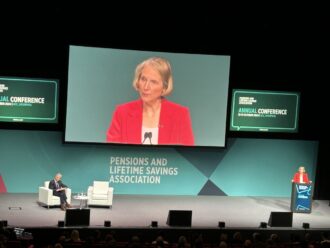The Bank of England (BoE) holding interest rates at 5.25% in March was probably expected, but it does seem to set out a road map for investors going forward.
Chris Arcari, head of capital markets at Hymans Robertson, understands why the Bank of England decided to err on the side of caution with regards to easing policy.
“Core inflation, which excludes volatile energy and food prices, is still more than double the bank’s target at 4.5%, year-on- year,” he said. “And service-sector price and wage growth, both running at 6.1%, year-on-year, are closely watched measures of genuine domestic price pressures. These data points more than justify the bank’s current wait-and-see approach.”
Arcari noted that declines in inflation are likely to open the door to rate cuts this year. “Even though the bank stopped raising rates in August last year, monetary policy has continued to tighten as real interest rates have risen as inflation has declined, and so a moderately restrictive monetary policy stance can be maintained, even as interest rates are lowered,” he said.
Additionally, he said that central banks do not target “realised inflation”, rather where they believe inflation will be over a forecast horizon. “Which may be a reason for a central bank reducing rates even if core or headline inflation is still above target,” he said.
Weak growth
Arcari said that given weak real GDP growth and declining inflation, “we see scope for two to three 0.25% rate cuts this year”.
However, he expects central banks, including the BoE, to err on the side of caution and look to slowly make rates less restrictive, rather than cutting rates to levels that would be considered stimulative.
“Given still strong underlying inflation pressures, we see the balance of risks pointing toward the central bank reducing rates less, rather than more, than the market expects,” Arcari added.
Damien Hill, senior portfolio manager at Insight Investment, also believes the Bank of England is nearing the peak of this rate hiking cycle. “But monetary policy uncertainty remains in the face of inflation remaining stubbornly above central bank targets and a tight labour market,” he said.
“The positive environment for risk markets looks likely to last for longer into 2024 than previously expected but it could still prove to be more transitory in nature if core inflation remains sticky and monetary policy has to remain tighter for longer to ensure more permanence in the move of inflation back within central bank targets,” Hill said.
Getting some credit
This leads Hill to a big conclusion: the demand picture for investment-grade credit appears strong looking forward, with institutional investors attracted by high investment-grade yields that now exceed the dividend yields of their headline equity counterparts.
“We will look to take advantage of any periods of spread weakness to add exposure, but we remain cognisant that there is significant uncertainty around the trajectory for inflation, central bank reaction functions and market volatility,” he said.
“Investment grade credit spreads continued to tighten in February as risk markets performed strongly with expectations remaining high that economic growth can remain resolute as monetary policy brings inflation back to central bank targets,” Hill added. “European investment-grade credit significantly outperformed its US dollar equivalent as a combination of weak relative value and record year-to-date issuance halted spread tightening in the US.”
Moreover, Hill said that valuations in sterling, and particularly euro investment grade, remain attractive versus those in the US dollar. “We have a neutral valuation score based on global investment grade spread levels but a positive from our spread momentum indicator. In this environment we are happy to run a directional long in credit and ready to add on weakness,” Hill said.
“We have a credit-cycle score in positive territory given the outlook for growth, real rates and inflation,” he added.
Easing cycle
In a similar way, April LaRusse, head of investment specialists at Insight Investment, believes that August is the likely starting point for the easing cycle. “With lower levels of inflation allowing rates to be gradually eased into year end.
“In our view, major central banks are likely to be far more conservative on inflation in the years ahead, meaning that the easing cycle could prove shallower than other periods in history,” she said.
Looking at the UK situation slightly differently, Philippe Noyard, global head of fixed income at Candriam, said the economy is still anchored in Europe, with weak inflation like the eurozone and a similar inflation trajectory.
“In light of this, we see market pricing of only two cuts from the BoE as probably not sufficiently aggressive,” Novard said. “With UK inflation set to fall markedly in the coming months, we see a first cut in the base rate coming at around the same time as those of the European Central Bank and the Fed.
“We are also somewhat reassured following the vote on the budget, the last one before the next general election, with the risk of pre-election fiscal largesse having now subsided. This has prompted us to re-introduce our long position on gilts.”





Comments